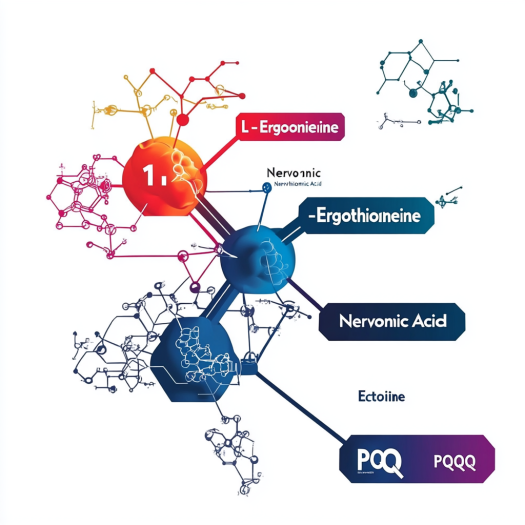
Have you ever stood at the crossroads of product formulation, torn between two powerhouse ingredients: PQQ and CoQ10?
PQQ and CoQ10 both support mitochondrial health, but PQQ promotes growth of new mitochondria while CoQ10 helps existing ones function better. Choosing depends on your product’s focus—energy regeneration or protection.
Let’s walk through their strengths, differences, and how to decide which fits best in your formulation toolbox.
What Are PQQ and CoQ10, and Why Are They So Popular?
These two ingredients are like the dynamic duo of cellular energy—but they work very differently.
PQQ stimulates the growth of new mitochondria, while CoQ10 primarily acts as an antioxidant that protects existing mitochondria from oxidative damage.

When I first started exploring mitochondrial health formulas1, I was drawn to CoQ10. It’s familiar, backed by decades of research, and trusted by both supplement brands and their users. But then I came across PQQ—short for Pyrroloquinoline Quinone—and it kind of blew my mind.
PQQ doesn’t just protect cells. It helps your body create more power plants—more mitochondria—especially in the heart and brain. That’s when I realized this wasn’t just a newer version of CoQ10. It was a different player with a unique skill set.
Here’s a simple comparison table to show what each one brings to the table:
| Feature | PQQ | CoQ10 |
|---|---|---|
| Mitochondria Growth | ✅ Yes | ❌ No |
| Antioxidant | ✅ Yes | ✅ Yes |
| Energy Production Support | ✅ Strong | ✅ Strong |
| Cognitive Benefits | ✅ Emerging | ✅ Supported |
| Anti-aging Potential | ✅ Strong | ✅ Moderate |
| Research Age | Newer | Decades of use |
Both have their place. But which one belongs in your product?
How Does PQQ Work in the Body?
To understand PQQ, you have to think bigger than just energy. This compound goes deep into your cells, encouraging them to upgrade their internal engines.
PQQ activates key pathways that stimulate the growth of new mitochondria, which are essential for brain, heart, and overall cellular vitality.

When we age—or when we’re just living modern, high-stress lives—our mitochondria wear out. Fewer mitochondria means less energy, more fatigue, and slower repair. That’s where PQQ shines.
It doesn’t just patch the damage. It tells your cells, “Hey, let’s build more engines.” This unique role is known as mitochondrial biogenesis.
In studies, animals given PQQ showed improved memory, learning speed, and heart function. Some human trials also hint at better cognitive sharpness and reduced markers of oxidative stress.
What I found fascinating while reading clinical reviews was that PQQ doesn’t interfere with CoQ10. In fact, combining them can be synergistic—but more on that later.
Learn more about our PQQ ingredient and its purity testing here.
What Are the Core Benefits of CoQ10?
CoQ10 might not build new mitochondria, but it’s the unsung hero that keeps your current ones humming.
CoQ10 helps cells produce ATP, the body’s energy currency, and protects mitochondria from free radical damage, especially in heart tissue.
If you’ve ever heard about CoQ10 and heart health, that’s no coincidence. It’s especially concentrated in cardiac muscle. Supplementing CoQ10 can improve outcomes in people with cardiovascular issues2 or those on statins, which tend to deplete natural CoQ10 levels.
It also supports skin health, fertility, and endurance performance. So while PQQ builds new engines, CoQ10 is your top-tier maintenance crew.
When I talk to supplement formulators, many start with CoQ10 because it’s familiar, safe, and effective. But once they try blending in PQQ, the results speak for themselves—customers notice more energy, clearer thinking, and a sense of revitalization.
Should You Combine PQQ and CoQ10?
This is the golden question—and the answer often surprises people.
Yes, combining PQQ and CoQ10 can enhance cellular energy and recovery, offering both regeneration and protection for mitochondria.
Imagine giving your cells not just a tune-up, but also installing a whole new engine system. That’s what happens when PQQ and CoQ10 work together.
One supports the growth of new mitochondria3 (PQQ), and the other ensures those new mitochondria are protected and functional (CoQ10). It’s a partnership that makes a lot of sense in energy-focused formulations—whether for aging, recovery, cognition, or active lifestyle products.
I’ve seen this combo thrive in:
- Cognitive health capsules for older adults or professionals
- Mitochondrial support tablets for athletes or high-energy lifestyles
- Functional drinks aimed at brain and body performance
Here’s a glimpse of how a dual-formula might look:
| Ingredient | Dosage | Function |
|---|---|---|
| PQQ | 10-20mg | Stimulates new mitochondria |
| CoQ10 (Ubiquinone/Ubiquinol) | 100-200mg | Supports mitochondrial function and antioxidant defense |
It’s worth noting that while CoQ10 is fat-soluble and best absorbed with meals, PQQ is water-soluble—offering formulation flexibility for different product formats.
Which One Should You Choose for Your Product?
If you’re developing a product line, your choice depends on the core problem you want to solve.
Choose PQQ if your product focuses on neuroprotection, anti-aging, or long-term energy regeneration; CoQ10 is better for cardiovascular support and energy maintenance.
Let me break it down by application:
| Product Type | Ideal Ingredient | Why |
|---|---|---|
| Brain Health Gummies | PQQ | Supports cognitive sharpness and mitochondrial growth |
| Heart Support Capsules | CoQ10 | Protects heart mitochondria, especially for older adults |
| Mitochondrial Energy Tablets | PQQ + CoQ10 | Full-spectrum support: growth + protection |
| Skincare Serums | CoQ10 | Antioxidant protection, reduces oxidative stress in skin |
| Recovery Powders | PQQ | Aids in faster cellular repair post-exercise or stress |
Still not sure? Here’s what I usually advise clients:
- Go with PQQ if you want to stand out with cutting-edge science and long-term cell rejuvenation.
- Stick with CoQ10 if you’re targeting a familiar, heart-focused audience.
- Combine both for a premium line that addresses aging, energy, and vitality holistically.
We offer both raw materials at Santa Biotech, and we’re happy to help you create a custom formulation that suits your market goals.
Explore our full PQQ product offering here.
Conclusion
PQQ and CoQ10 are both excellent—but each serves a different purpose. The best choice depends on your formulation goals and customer needs.
Let me know if you’d like a sample or formulation idea—happy to help.
-
Explore top-rated mitochondrial health formulas to optimize your energy levels and cellular health effectively. ↩
-
Discover the impact of CoQ10 on cardiovascular health and how it can improve outcomes for those with heart conditions. ↩
-
Understanding mitochondria’s role in energy production can enhance your knowledge of cellular health and vitality. ↩

